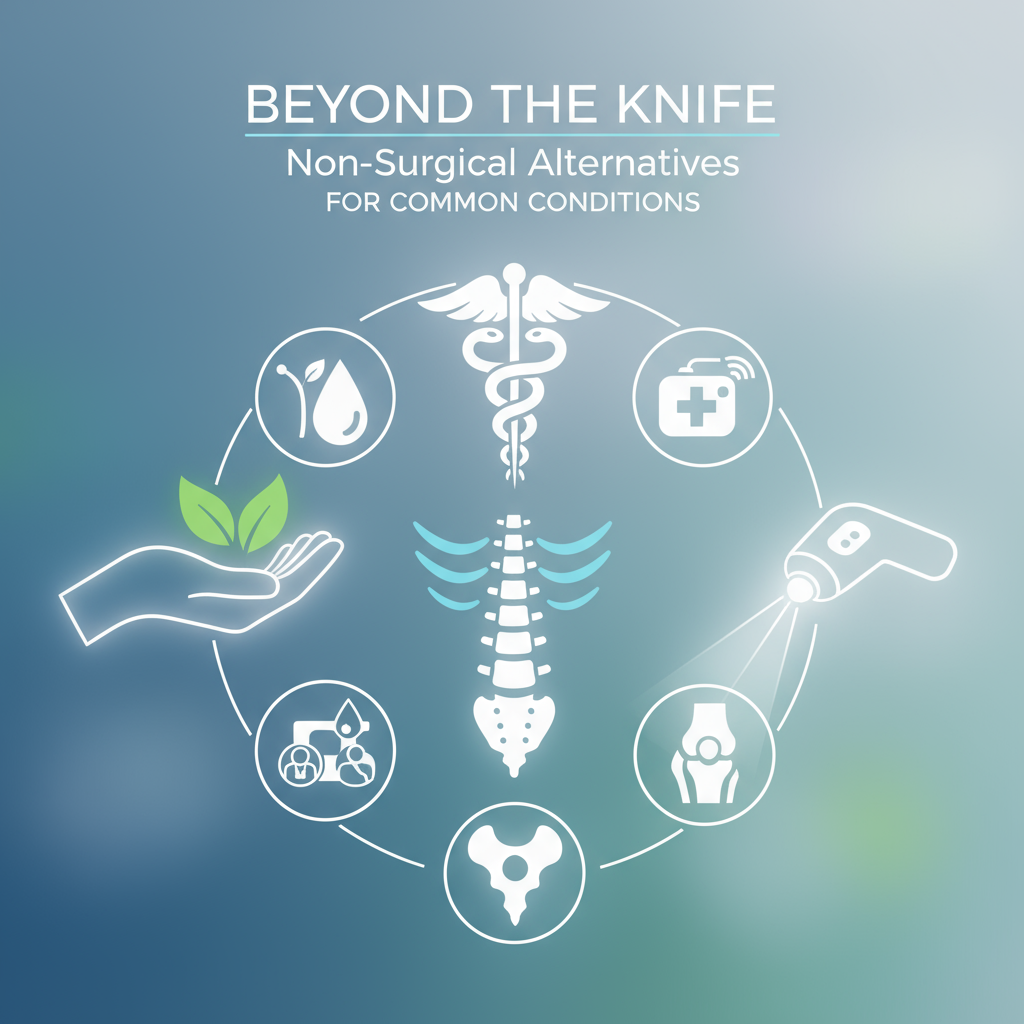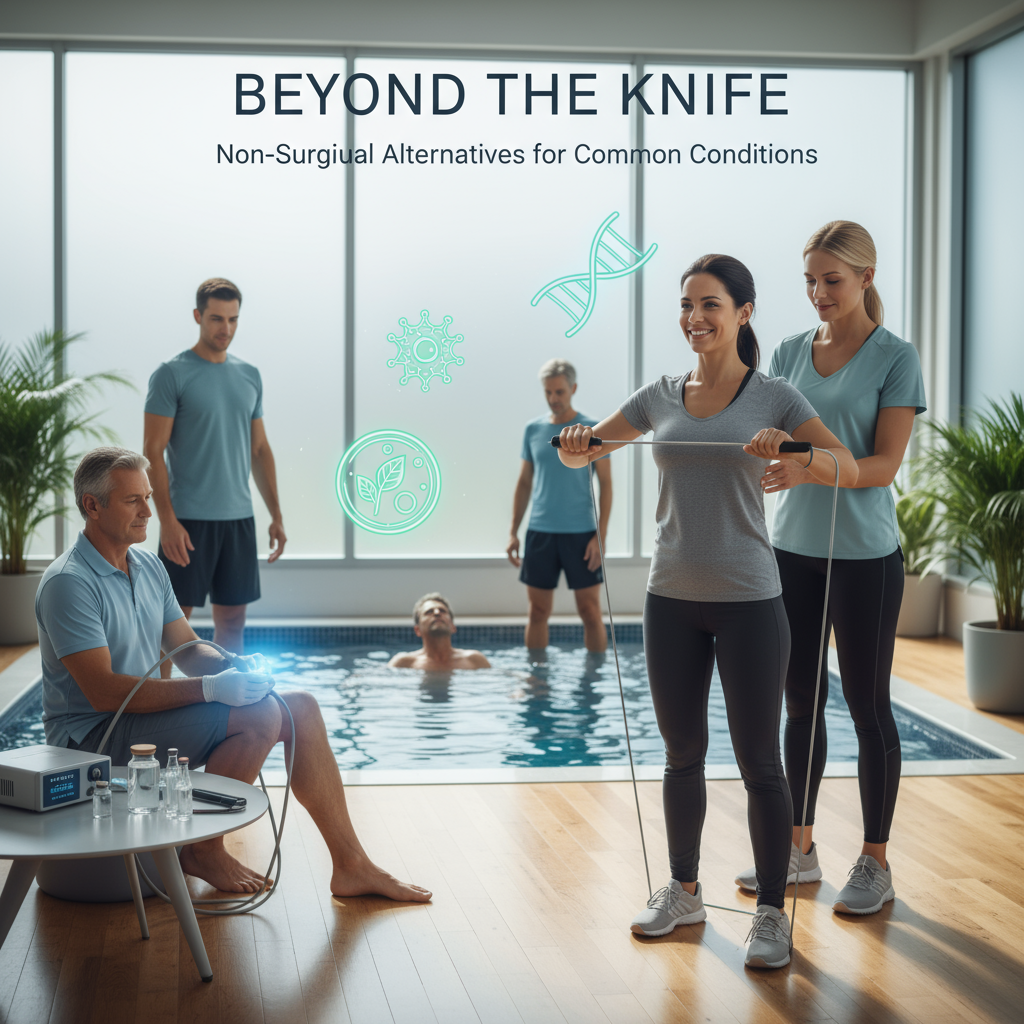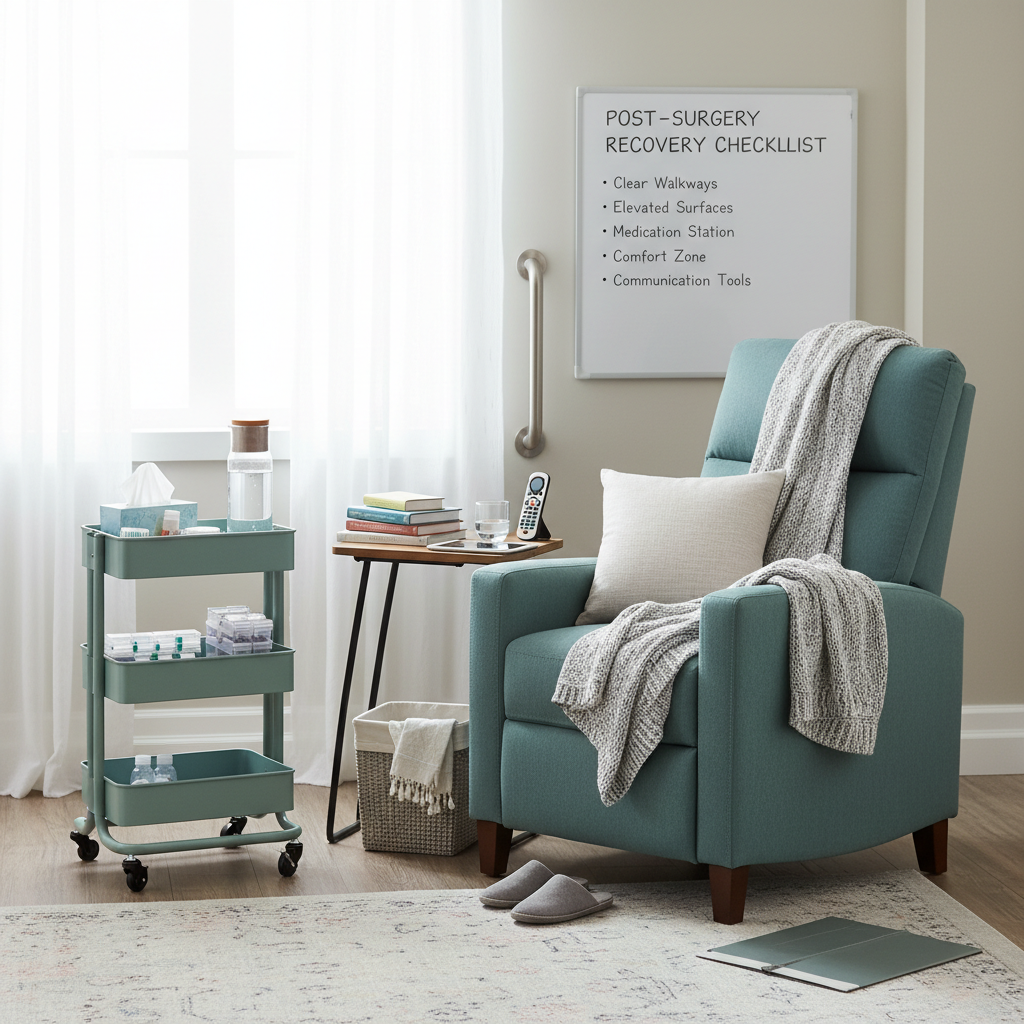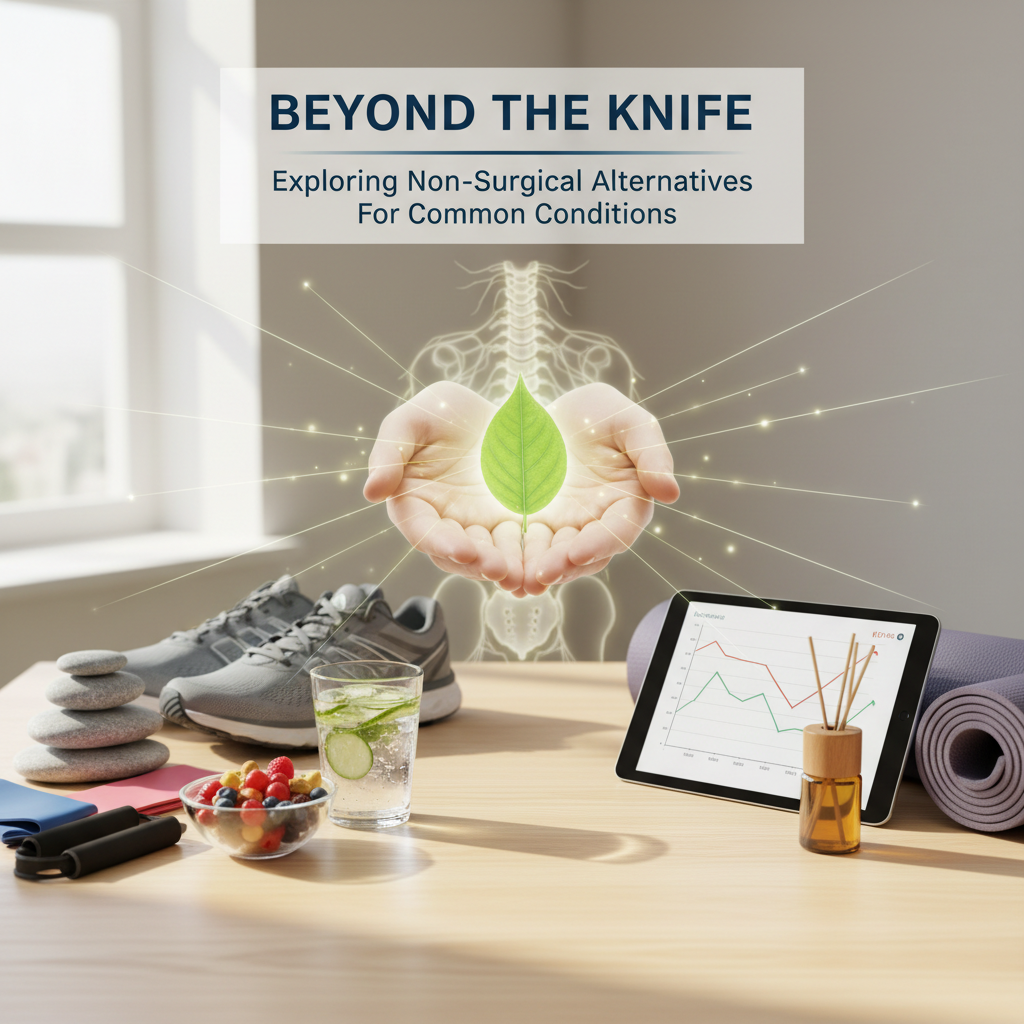Beyond the Knife: Non-Surgical Alternatives for Common Conditions
Beyond the Knife: Non-Surgical Alternatives for Common Conditions
Who this is for: You’re an active adult, a desk-bound professional with a cranky back, a weekend pickleball warrior, or a patient told “you’ll probably need surgery” for knees, shoulders, or spine issues. What’s frustrating: The pain keeps hijacking your workouts and your work, you don’t want downtime, and you’re not convinced the knife is your only option—yet the internet is noisy, your friend swears by cortisone, and you just want a clear plan that actually works. How we help: Our clinicians build structured, evidence-informed non-surgical treatment plans that blend physical therapy, targeted pain management, and regenerative medicine—so you understand your choices, see progress in weeks, and only consider surgery if you truly need it. Learn more about consider surgery if you truly need it.
What do “non-surgical treatments” include?
Short answer: far more than ice and hope. Think of non-surgical care as a playbook that reduces pain, restores function, and—often—delays or avoids surgery entirely. Learn more about delays or avoids surgery entirely.
- Physical therapy and exercise therapy: Mobility, strength, motor control, load management, gait/form retraining.
- Pain management: NSAIDs, topical analgesics, short courses of nerve or steroid injections, radiofrequency ablation for certain nerves.
- Regenerative medicine: Platelet-rich plasma (PRP), bone marrow concentrate (BMC) for tendons, ligaments, and some joints.
- Mechanics and supports: Bracing, taping, orthotics, ergonomic changes, activity modification.
- Modalities: Shockwave (ESWT), blood flow restriction (BFR), dry needling, acupuncture.
- Mind-body strategies: CBT-I for sleep, pain reprocessing, breathwork—pain is a bio-psycho-social experience.
Why this matters: single “silver bullets” are rare. Multimodal plans tend to win.
Are alternatives to surgery effective for common conditions?
Yes—often. Not always. The trick is matching the right tool to the right diagnosis and giving it a fair window (usually 6–12 weeks) with measurable goals.
Knee osteoarthritis: Can I avoid a knee replacement?
Many can delay it for years. Progressive strengthening, weight management (even 5–10 lb off changes knee load), and activity swaps (elliptical over running during flares) reduce pain. PRP shows meaningful improvements for mild-to-moderate OA; hyaluronic acid helps some patients around month 1–6. Cortisone? Good for short-term relief, not a long-term strategy.
What I’ve seen: patients who give PT 12 focused weeks—hip and quad strength, balance, cadence work—often cut pain by 30–50% and get back to hiking. If pain plateaus, PRP can stack another 20–30% improvement.
Lumbar disc herniation and sciatica: Do I need surgery?
If there’s progressive weakness, loss of bowel/bladder control, or foot drop—go surgical consult now. Otherwise, 80%+ of sciatica calms with 8–12 weeks of graded extension/flexion-based PT, nerve glides, sleep and sitting strategies, and possibly an epidural steroid injection for severe flares. Many runners are back to base mileage by week 10, carefully.
Rotator cuff tears: Can therapy beat the scalpel?
Partial tears respond well to PT, scapular control, and load progression; PRP may help tendinopathy. Full-thickness tears in older adults can still function with strong deltoid/scapular compensation. Large acute tears in younger or overhead workers often belong in a surgical lane—so speed matters. A targeted 10–12 week PT trial clarifies responders.
Tennis elbow (lateral epicondylitis): Is PRP worth it?
Graded loading and eccentric work are the foundation. Shockwave plus a well-structured program moves the needle for many by week 6. PRP has stronger mid-term data than steroid for tendons—steroid can feel great for 2–4 weeks then… crash. If pain persists past 12 weeks of good rehab, PRP is a legit step.
Plantar fasciitis: How fast can this calm down?
Night splints, calf/plantar loading, shoe changes, and shockwave help. A lot. Most cases settle in 6–12 weeks. PRP is an option for stubborn cases, and it’s often the difference-maker for people on their feet all day (nurses, teachers, retail).
Carpal tunnel syndrome: Can I avoid release surgery?
Wrist splinting at night, nerve/tendon glides, ergonomic fixes, and ultrasound-guided hydrodissection can relieve symptoms. If numbness is constant and EMG shows severe compression—surgery is usually the efficient fix. Mild-to-moderate cases often improve without it.
Physical therapy vs. surgery: how do you decide?
Look, the decision isn’t philosophical—it’s practical. What gets you safely back to the life you want the fastest, with the least risk and the best durability?
- Start with PT if there’s no red flag (instability you can’t control, major weakness, severe structural blockage).
- Define a trial: 8–12 weeks, 2–3 sessions/week initially, daily home program, and weekly objective markers (strength, range, step count, pain during a key task).
- Use decision thresholds: If you’ve gained 30%+ function and pain is trending down by week 6, keep going. If you’re flat or worse despite high adherence, escalate—imaging, injections, or surgical consult.
- Know exceptions: Large displaced meniscus locking the knee, Achilles ruptures, complete ACL tear in a pivoting athlete—those often need quicker surgical discussions.
In my experience, the clarity comes fast when the plan is structured. You’ll feel it by week 4–6.
What is regenerative medicine—and is it legit?
Regenerative medicine taps your biology to promote healing—most commonly PRP (concentrated platelets from your blood) and bone marrow concentrate (cells and growth factors from your marrow).
- PRP shines for tendinopathies (tennis elbow, patellar, hamstring) and mild-to-moderate knee OA. Expect gradual gains over 6–12 weeks, with peak effect around 3–6 months.
- BMC is considered for stubborn tendon tears or moderate OA where PRP wasn’t enough. It’s a bigger step—discuss thoroughly.
Risks are low (soreness, rare infection). Results depend on diagnosis quality, precise ultrasound-guided delivery, and the rehab you pair with it. I’d argue the “recipe” matters more than the brand of centrifuge.
Costs vary by region: PRP typically $550–$1,200 per treatment; BMC $2,800–$5,500. Insurance rarely covers PRP/BMC. Patients often plan 1–3 PRP sessions spaced 4–6 weeks apart if needed.

Injections that help without surgery: which and when?
- Corticosteroid — Quick relief for inflamed bursae or joints. Useful to break a pain cycle so you can rehab. Not a long-term habit, especially for tendons.
- Hyaluronic acid (viscosupplement) — Lubricates arthritic knees. Some feel smoother motion by week 2–4; others feel little. Pair with strength training.
- PRP — Healing stimulus for tendons/ligaments and OA symptom relief. Slower on-ramp, better durability.
- Epidural steroid — Calms inflamed nerve roots in sciatica. Often buys a 6–12 week window to get strong.
- Genicular or medial branch blocks → radiofrequency ablation — For knee OA or facet-related back pain. If diagnostic blocks help, RFA can deliver 6–12 months of relief.
- Hydrodissection — Fluid separates a nerve from sticky tissues (carpal tunnel, radial tunnel). Often combined with PT and splinting.
Do non-surgical pain management options fix the problem—or just mask it?
Both exist. Passive-only pain relief can mask. Active care changes tissue capacity and movement quality, which is what holds long-term. The best plans pair short-term relief (so you can move) with progressive loading (so you stay better). That’s why people who combine targeted injections with structured PT usually outperform either alone.
How long do results last?
- PT-driven improvements — As long as you maintain the habit. Lose the habit, lose the gains. Simple, not easy.
- Corticosteroid — Days to a few weeks for tendons; sometimes 6–12 weeks in joints.
- Hyaluronic acid — 3–6 months if you’re a responder.
- PRP — Progressive improvement over 3–6 months, often durable at 12+ months for tendons.
- RFA — Commonly 6–12 months; nerves can regenerate.
I’ve noticed durability tracks with the consistency of your strength and movement practice. No surprise there.
What are the risks—and who should avoid certain non-surgical options?
- PT/exercise — Low risk; overzealous loading can flare symptoms. Good coaching matters.
- NSAIDs — Stomach, kidney, and heart considerations. Use the lowest effective dose, shortest time.
- Corticosteroid — Repeated tendon injections increase rupture risk; may raise blood sugar briefly.
- PRP/BMC — Bleeding, infection (rare), post-injection soreness. Avoid if active infection, certain blood disorders, or uncontrolled autoimmune flares.
- Epidurals — Headache, bleeding, infection, transient sugar rise—discuss with anesthesia/pain specialist.
- RFA — Numbness or neuritis in a small minority; typically self-limited.
Always align choices with your medical history. If this feels overwhelming, our team can handle it for you—evaluate risks, map the sequence, and guide you every step.
What does a non-surgical care plan look like—week by week?
Here’s a simple 12-week roadmap for a chronic knee or shoulder.
- Weeks 1–2 — Diagnosis confirmed, pain triggers identified. Start gentle mobility and isometrics. Sleep and work setup adjusted. Baseline measures set.
- Weeks 3–4 — Progressive loading 2–3x/week, light cardio. Consider a short-acting injection if pain blocks training.
- Weeks 5–6 — Add power/end-range work, balance, and movement skill. Re-test. If stalled, consider PRP for tendinopathy or HA for knee OA.
- Weeks 7–8 — Load the pattern that matters (stairs, serve, squat) with coaching. Shockwave or BFR if indicated.
- Weeks 9–10 — Sport/work simulation, deload week if needed. Second PRP if planned.
- Weeks 11–12 — Consolidate gains. Build a 10–15 minute maintenance routine. Decide on ongoing needs (brace for long hikes, periodic tune-ups).
People ask, “How fast will I feel better?” Some feel small wins by week 2. Meaningful change usually shows by week 6 if you’re consistent.
What about costs and insurance?
Let’s be practical.

- Physical therapy — Often insurance-covered; co-pays vary ($20–$60). Cash sessions usually $95–$165.
- Shockwave — Commonly cash-based, $150–$300 per session, 3–6 sessions typical.
- PRP — $550–$1,200 per treatment. Many people do 1–2 for tendons.
- Epidural steroid — Usually covered with imaging and appropriate indications.
- RFA — Often covered if diagnostic blocks are positive.
Pro tip: ask for a written plan that sequences steps and costs. No surprises is the goal. Our coordinators do this all day—happy to lay it out in plain English.
Real-world snapshots
Runner, 39, sciatica after a deadlift PR — McKenzie-based extension work, neural glides, and one epidural at week 3. Back to easy runs by week 5, workouts by week 9. No surgery.
Nurse, 47, plantar fasciitis — Night splint, calf loading, shockwave x4, shoe changes. Pain 7/10 to 2/10 by week 8. PRP offered as a backup; never needed it.
Contractor, 55, rotator cuff partial tear — Scapular mechanics, progressive loading, one PRP to supraspinatus at week 5. Lifting overhead at work by week 10, steady at 6-month check-in.
People also ask: fast answers
What are the best non-surgical alternatives to knee surgery?
PT with hip/quad strengthening, weight management, activity swaps, bracing as needed, and either PRP or hyaluronic acid depending on your profile. Cortisone only to break a flare.
Is physical therapy enough for a meniscus tear?
Often yes, especially degenerative tears. Try 8–12 weeks of structured PT. Consider surgery sooner if your knee keeps locking or you can’t straighten it fully.
Does PRP actually work?
For tendinopathy and mild-to-moderate knee OA, many patients see meaningful improvements by 3–6 months—especially when paired with good rehab.
How long should I try non-surgical treatments before surgery?
Six to twelve weeks with objective progress checks is a fair trial. Urgent signs like progressive weakness or mechanical locking change that timeline.
Can non-surgical treatments delay joint replacement?
Yes—strength, weight loss, HA/PRP, and bracing can delay replacement for years in some patients, while keeping function up.
Seasonal reality check
It’s fall marathon season—Chicago, Marine Corps, NYC—so knee and Achilles flare-ups are spiking right now. Don’t panic-train through it. A quick load audit, targeted strength, and (if needed) a short-term injection can salvage your race without blowing up your season.
How to choose the right clinic for non-surgical care
- Integrated team: PT, sports med, and injection experts who talk to each other.
- Ultrasound-guided procedures: Precision matters for injections.
- Measurable plans: Written goals, timelines, and decision thresholds.
- Conservative-first, not conservative-only: They’ll escalate when the data says so.
If your gut says you’re being rushed or sold something shiny, press pause. Ask for the plan in writing.
Your next steps
So here’s the thing about pain: it blurs decision-making. A clean plan clears it up. Book a thorough evaluation, get a diagnosis you trust, and map a 12-week non-surgical plan with checkpoints. If you’d like, our team can do this for you—exam, imaging review, and a step-by-step plan that fits your goals, schedule, and budget. No pressure, just clarity.
Info only, not medical advice. If you have red-flag symptoms—sudden weakness, loss of bowel/bladder control, fever with severe pain—seek urgent care.




